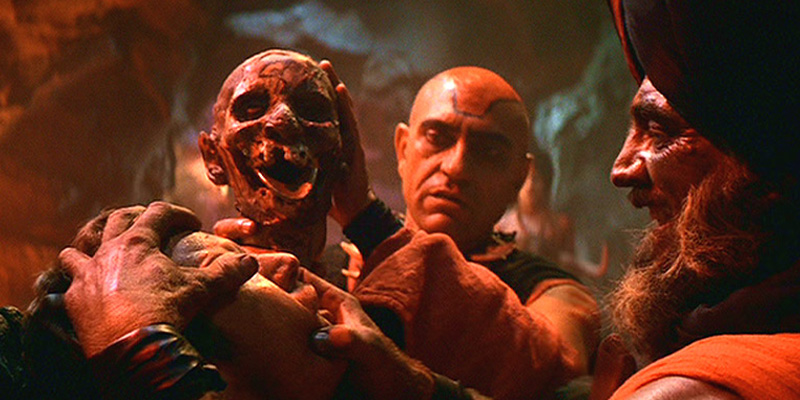 Whenever Hindus try and speak out on any issue they are constantly lambasted as fascist, fundamentalist and pro-caste. This is a specialty of the unholy axis between right wing Christian and Islamist hatecore groups and Marxists in their joint strategy for blaming all India ’s problems on Hinduism. While to many it would seem strange how hardcore radical leftist atheists would join hands with obscurantist right wing religious groups there is no doubt that the language employed and the issues raised are the same, indeed repetitively so.
Whenever Hindus try and speak out on any issue they are constantly lambasted as fascist, fundamentalist and pro-caste. This is a specialty of the unholy axis between right wing Christian and Islamist hatecore groups and Marxists in their joint strategy for blaming all India ’s problems on Hinduism. While to many it would seem strange how hardcore radical leftist atheists would join hands with obscurantist right wing religious groups there is no doubt that the language employed and the issues raised are the same, indeed repetitively so.
This is most notable in discussing inequality, which is always associated with caste. India ’s communal problems are always blamed on Hindu extremists who are labelled the heirs to Hitler’s ideology. But how much truth is there in this? Does fascism actually exist in India ? The answer to the second question would always be yes, look at the BJP, VHP and RSS.
However doing that does raise a few problems, not least in that any type of Hindu activism is associated with such groups and thereby labelled fascist. But then what do we mean by fascism? Even if we go by common stereotypes this becomes very problematic in that it is the BJP and such groups which have always urged a pro-Israel foreign policy for India . The Marxist-Christian axis may laugh this off but can they be so dismissive when Hitler loyalists such as Remer took their anti-Semitism to its logical extreme by helping the Nazi admiring regimes of Nasser and Assad, in Egypt and Syria respectively? Also such Hindu groups proudly parade the fact that Jews flourished in India for two millennia with no trace of hostility from the majority community. That hardly makes for harmonious ideology with Mein Kampf.
 Fascism is an amorphous term synonymous with extreme right-wing nationalist. But this again entails more problems than it clarifies. In 1944 Nobel prize winning economist FA Hayek traced the roots of fascism and especially Nazism (which he called by its original German name of “national-socialism”) back to the Left, namely Marxist and other socialist theories. The rise of racist, revanchist and ultra-nationalist groups in former communist Europe since 1989 has to a large extent vindicated this view. Hayek’s posthumous prophecy has been most pronounced in Russia where the worst levels of Nazi skinhead racial violence is only a reflection of the crude nationalism exhibited by former hardcore communists.
Fascism is an amorphous term synonymous with extreme right-wing nationalist. But this again entails more problems than it clarifies. In 1944 Nobel prize winning economist FA Hayek traced the roots of fascism and especially Nazism (which he called by its original German name of “national-socialism”) back to the Left, namely Marxist and other socialist theories. The rise of racist, revanchist and ultra-nationalist groups in former communist Europe since 1989 has to a large extent vindicated this view. Hayek’s posthumous prophecy has been most pronounced in Russia where the worst levels of Nazi skinhead racial violence is only a reflection of the crude nationalism exhibited by former hardcore communists.
To this extent Jonah Goldberg’s Liberal Fascism has perhaps been the best updated version of Hayek’s analysis. In this we find that so many movements which begin as revolutionary, statist and especially socialist end up being fascist.
So how does this relate to India ? The republic prides itself on being a socialist state. What was the Emergency is it was not an attempted putsch? If one looks into Nehru’s past we find undying love for the USSR . Yet less well known is how India ’s first prime minister was invited to tour the Third Reich and exhibited rather unsavoury anti-Semitic sentiments as well as sympathy for the pro-Nazi elements among Arab nationalism.
As any NRI ( non resident Indian ) would know the country has a mind boggling set of often contradictory bureaucratic hurdles, even if these have eased somewhat. As ‘outsiders’ the NRI is subject to the full iron fist of these various forms, regulations and other soul destroying mechanisms which the right bribe would quickly render irrelevant. But what is rarely brought out is the xenophobic nature of these. When not viewed as money laden milch cows, NRI’s are looked down upon in a similar manner to how nissei (descendants of Japanese immigrants to Brazil ) are treated as social lepers by ultranationalists when they become guest workers in their ancestral homeland of Japan . By hardening caste boundaries through affirmative action quotas, the Indian state has created pseudo-ethnic friction through the application of a racial mythology in which a primeval Aryan race oppressed the natives.
This ideological offal is supported by the Marxist-Christian hatecore axis, who conveniently ignore just where this led  to in Rwanda in 1994. In India fascism is exhibited by a host of casteist, Leftist, regionalist and minority right wing religious fundamentalist groups for which the ‘Hindu’ is the common enemy, much as the ‘Jew’ was to organic and romantic nationalists in nineteenth century Europe . The fact that the Hindus may be in a demographic majority makes no difference when one considers how a majority can be the victim of unending hate as blacks were in South Africa for hundreds of years.
to in Rwanda in 1994. In India fascism is exhibited by a host of casteist, Leftist, regionalist and minority right wing religious fundamentalist groups for which the ‘Hindu’ is the common enemy, much as the ‘Jew’ was to organic and romantic nationalists in nineteenth century Europe . The fact that the Hindus may be in a demographic majority makes no difference when one considers how a majority can be the victim of unending hate as blacks were in South Africa for hundreds of years.
India ’s Marxist academics and socialist planning have created the fascist mindset which has led to xenophobia, caste competition, aggressive missionary tactics and the annihilation of Hindus from parts of the country. To understand this one only need to examine how the liberal nationalism and high ideals of the French Revolution led to what many see as the diametric opposite to the Jacobin state: the romantic German nationalism of Fichte, and the organic French nationalism of Charles Maurras.
Goldberg also mentions how we have misunderstood totalitarianism. The image of ‘Big Brother’ always looms large in how such a state would look. But it is now clear that far from being a prophet, Orwell merely reflected the nature of his times. Nineteen Eighty-Four was written as Stalinism was a real threat and unlike Orwell other socialists and liberals, the “useful idiots” as Lenin termed such naïve idealists, would not wake up and smell the coffee.
For example Jean-Paul Sartre was so concerned about the reality of life in the USSR demoralising the proletariat in the capitalist countries, he preferred to avert his gaze until the plight of the Vietnamese boat people made it too obvious that communism really was not creating an earthly paradise. No, the prophet of totalitarianism is a title which should be awarded to Aldous Huxley. Brave New World looks benign with its addictive hedonism, notably recreational sex. But look deeper and what we find is a society of unthinking androids, lack of deep thinking, and no emotional ties of family and friends. Nobody is mourned when they die because nobody misses them. While Orwell was concerned that in his nightmare books would be banned, in Huxley’s teddy-bear vision there is no need to ban books because nobody  reads them. How far does Huxley’s vision reflect modern India ? Marxist domination of academia has killed off creative thinking.
reads them. How far does Huxley’s vision reflect modern India ? Marxist domination of academia has killed off creative thinking.
This is most obvious in the humanities where Stalinist professors create unthinking clones of themselves and then like the pigs in Animal Farm jump at the first opportunity to gain lucrative relationships with the ‘other side’, in this case the very imperialist capitalist west which they so often denounce, and get plum appointments at institutions where they can find yet more unsuspecting victims to harangue with their unlettered monologue. Hence why India has brought out little that is new in these subjects as the past is regurgitated and vomited with nobody even bothering to clean up the mess. That is why Indians leaving to work aboard are most often in the sciences where one needs to think only straight and logic.
It is fortunate that India did not produce its very own versions of Lysenko to force science into an ideological straightjacket. As India rises from decades of Nehru-Gandhian national socialism, the Huxleyan nightmare looms large.
Look at the majority of bollywood movies or television channels and it is the same repetitive and unimaginative mix of mind destroying hedonism usually involving scantily clad half attempts of burlesque combined with even more laughable attempts to mime cheesy tunes, taken from the latest issue of cellular vomit. Without the liberal and civic values which in western countries have counterbalanced predatory consumerism, India is subjected to a fast paced fantasy world which appeals to the rawest and most destructive forms of sensuality.
 This is not inspiration but destructive escapism as India’s elite and those aspiring to join it live in a ‘brave new world’ aloof from the masses, the ‘savages’ from Huxley’s novel. As social structures loosen the former strictures of caste in its place we find not an egalitarian society, but millions of atomised individuals with nothing to buffer between them and the state. In such a potent mix dangerously romantic and organic ideas will create new bonds much tighter than the social structure which is being discarded. In a civilisation that inspired Huxley and others with its deep spirituality, a crude and uncompromising form of hedonism has become the standard reference point.
This is not inspiration but destructive escapism as India’s elite and those aspiring to join it live in a ‘brave new world’ aloof from the masses, the ‘savages’ from Huxley’s novel. As social structures loosen the former strictures of caste in its place we find not an egalitarian society, but millions of atomised individuals with nothing to buffer between them and the state. In such a potent mix dangerously romantic and organic ideas will create new bonds much tighter than the social structure which is being discarded. In a civilisation that inspired Huxley and others with its deep spirituality, a crude and uncompromising form of hedonism has become the standard reference point.
Nature abhors a vacuum and out of the atomised flotsam and bohemian chattering classes a menacing alternative awaits to take its place. In this atmosphere there is no place for the individual, for creativity, for deep thinking and for the solitude which was necessary for India to produce such great minds as in the past. Only mindless androids, human sheep and faceless characters can hope to succeed in such an environment. This is fascism Indian style and it is the diametric opposite to the values which are found in Hindu Dharma.
































1 Comment